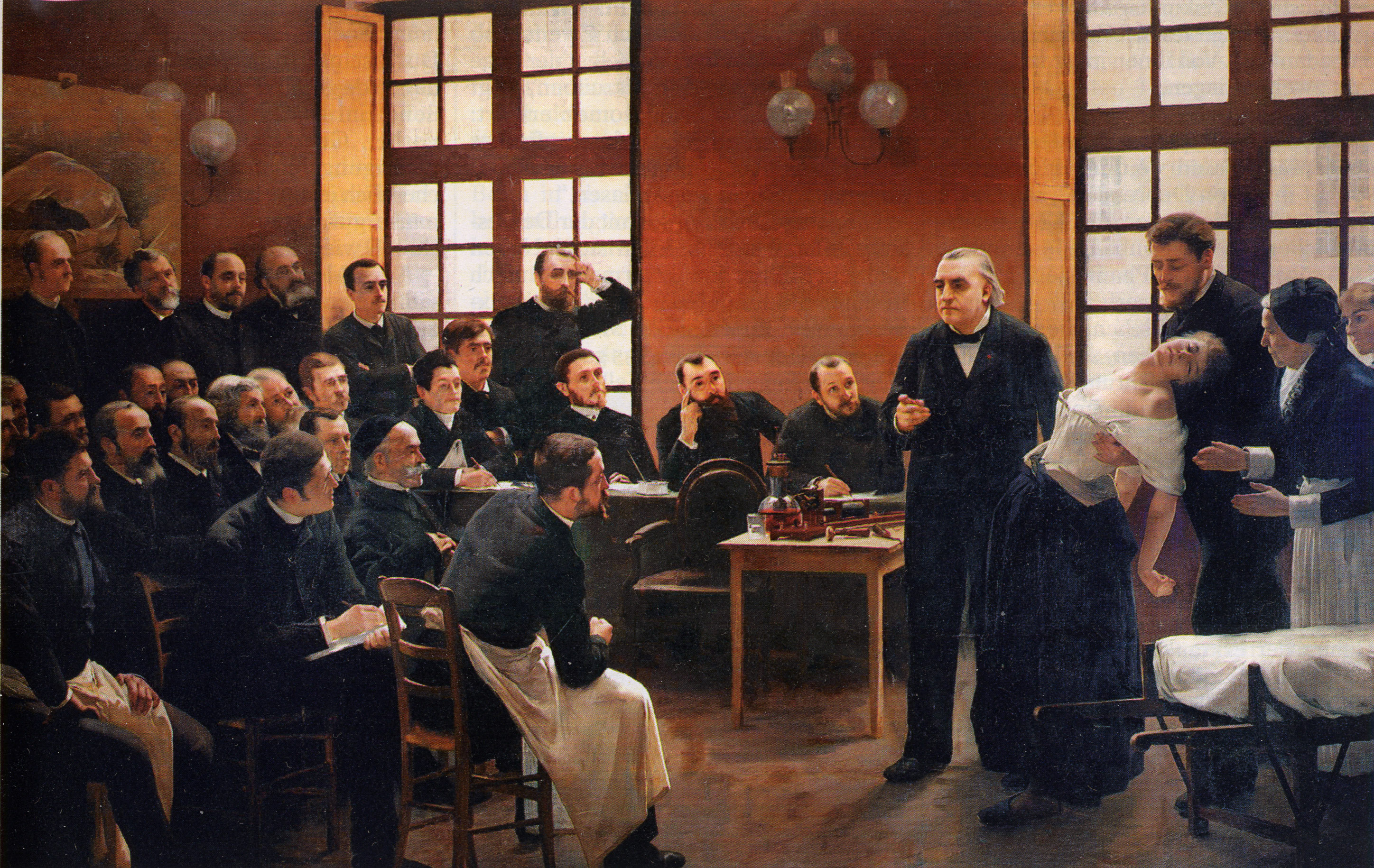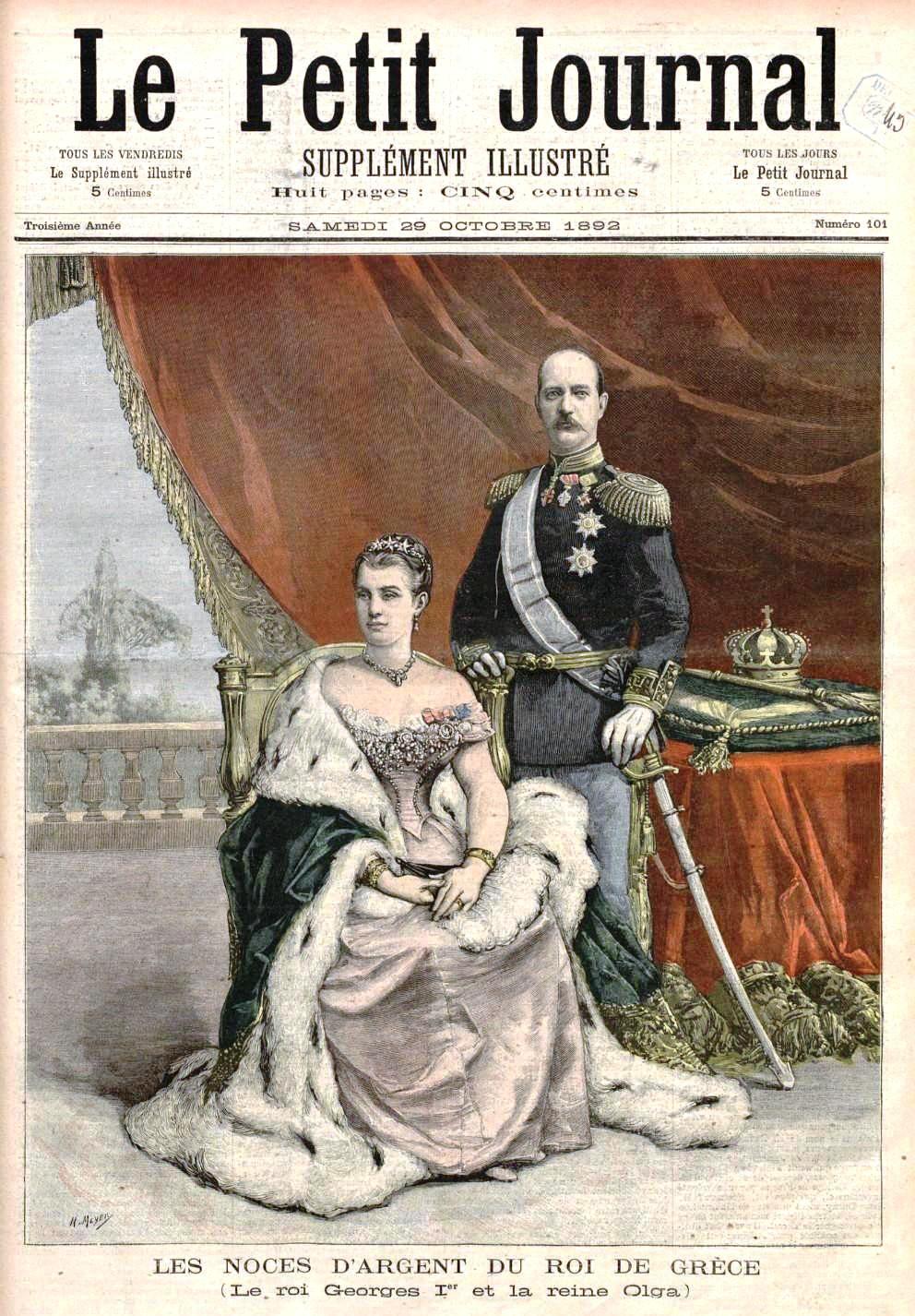|
André Brouillet
Pierre Aristide André Brouillet (1 September 1857 – 6 December 1914) was a French academic painter specialising in genre painting, portraits and landscapes. Life Born in Charroux, the son of sculptor Pierre-Amédée Brouillet and Élisabeth Leriget, Brouillet began engineering studies at the École centrale Paris in 1876 before entering the École nationale supérieure des beaux-arts three years later, where he was a student of Jean-Léon Gérôme.. In the year of his reception at the Salon de peinture et de sculpture in 1879, he attended Jean-Paul Laurens' lessons. During his career, he received numerous exhibition awards and numerous public commissions. He is best known for his painting '' A Clinical Lesson at the Salpêtrière'' which represents the neurologist Jean Martin Charcot examining the hysterical patient Marie Wittman, during one of these famous "Tuesday lessons", which he had made a real show. Charcot is represented there with a large number of his students ... [...More Info...] [...Related Items...] OR: [Wikipedia] [Google] [Baidu] |
Charroux, Vienne
Charroux () is a commune in the Vienne department in the Nouvelle-Aquitaine region in western France. The remains of the Benedictine Charroux Abbey, founded in the 8th century, are preserved in the town. Said to be the site of the council of Charroux in 989 where the bishops of Aquitaine met to protect the immunity of the clergy and suggested that the church should guarantee that the poor might live in peace. Demographics See also *Communes of the Vienne department The following is a list of the 266 communes of the Vienne department of France France (), officially the French Republic ( ), is a country primarily located in Western Europe. It also comprises of Overseas France, overseas regions ... References Communes of Vienne {{Vienne-geo-stub ... [...More Info...] [...Related Items...] OR: [Wikipedia] [Google] [Baidu] |
Joseph Babinski
Joseph Jules François Félix Babinski ( pl, Józef Julian Franciszek Feliks Babiński; 17 November 1857 – 29 October 1932) was a French-Polish professor of neurology. He is best known for his 1896 description of the Babinski sign, a pathological plantar reflex indicative of corticospinal tract damage. Life Born in Paris, Babinski was the son of a Polish military officer, Aleksander Babiński (1824–1889), and his wife Henryeta Weren Babińska (1819–1897),Joseph Babinski nndb.com who in 1848 fled for because of a Tsarist reign of terror instigated to stall Polish attempts at achieving independence an ... [...More Info...] [...Related Items...] OR: [Wikipedia] [Google] [Baidu] |
Henri Lafontaine
Henri is an Estonian, Finnish, French, German and Luxembourgish form of the masculine given name Henry. People with this given name ; French noblemen :'' See the ' List of rulers named Henry' for Kings of France named Henri.'' * Henri I de Montmorency (1534–1614), Marshal and Constable of France * Henri I, Duke of Nemours (1572–1632), the son of Jacques of Savoy and Anna d'Este * Henri II, Duke of Nemours (1625–1659), the seventh Duc de Nemours * Henri, Count of Harcourt (1601–1666), French nobleman * Henri, Dauphin of Viennois (1296–1349), bishop of Metz * Henri de Gondi (other) * Henri de La Tour d'Auvergne, Duke of Bouillon (1555–1623), member of the powerful House of La Tour d'Auvergne * Henri Emmanuel Boileau, baron de Castelnau (1857–1923), French mountain climber * Henri, Grand Duke of Luxembourg (born 1955), the head of state of Luxembourg * Henri de Massue, Earl of Galway, French Huguenot soldier and diplomat, one of the principal commanders ... [...More Info...] [...Related Items...] OR: [Wikipedia] [Google] [Baidu] |
Henry Gréville
Alice Marie Céleste Durand (' Fleury; 12 October 1842 in Paris – 26 May 1902) was a French writer best known under her pen name Henry Gréville. The daughter of a professor, she accompanied her father to St. Petersburg, studied languages and science and married Émile Durand, a French law professor at Petersburg, with whom she returned to France in 1872. Gréville had already published novels in St. Petersburg journals: ''A travers des champs'' and ''Sonia'', and continued her production in France, first with the novels ''Dosia'' (1876) and ''L'Expiation de Savéli'' (1876), depicting Russian society. Her first full novel ''Dosia'' was awarded the Montyon Prize The Montyon Prize (french: Prix Montyon) is a series of prizes awarded annually by the French Academy of Sciences and the Académie française. They are endowed by the French benefactor Baron de Montyon. History Prior to the start of the French ... and saw many editions. Her books were translated in many Europe ... [...More Info...] [...Related Items...] OR: [Wikipedia] [Google] [Baidu] |
Rape Of Belgium
The Rape of Belgium was a series of systematic war crimes, especially mass murder and deportation and enslavement, by German troops against Belgian civilians during the invasion and occupation of Belgium in World War I. The neutrality of Belgium had been guaranteed by the Treaty of London (1839), which had been signed by Prussia. However, the German Schlieffen Plan required that German armed forces pass through Belgium (thus violating Belgium's neutrality) in order to outflank the French Army, concentrated in eastern France. The German Chancellor Theobald von Bethmann Hollweg dismissed the treaty of 1839 as a "scrap of paper". Throughout the war, the German army systematically engaged in numerous atrocities against the civilian population of Belgium, including the intentional destruction of civilian property; German soldiers murdered over 6,000 Belgian civilians, and 17,700 died during expulsion, deportation, imprisonment, or death sentence by court. The Wire of Death, ma ... [...More Info...] [...Related Items...] OR: [Wikipedia] [Google] [Baidu] |
Légion D'honneur
The National Order of the Legion of Honour (french: Ordre national de la Légion d'honneur), formerly the Royal Order of the Legion of Honour ('), is the highest French order of merit, both military and civil. Established in 1802 by Napoleon Bonaparte, it has been retained (with occasional slight alterations) by all later French governments and regimes. The order's motto is ' ("Honour and Fatherland"); its seat is the Palais de la Légion d'Honneur next to the Musée d'Orsay, on the left bank of the Seine in Paris. The order is divided into five degrees of increasing distinction: ' (Knight), ' (Officer), ' (Commander), ' (Grand Officer) and ' (Grand Cross). History Consulate During the French Revolution, all of the French orders of chivalry were abolished and replaced with Weapons of Honour. It was the wish of Napoleon Bonaparte, the First Consul, to create a reward to commend civilians and soldiers. From this wish was instituted a , a body of men that was not an order of ... [...More Info...] [...Related Items...] OR: [Wikipedia] [Google] [Baidu] |
Femina (France)
''Femina'' was a French magazine created on February 1, 1901 by Pierre Lafitte and discontinued in 1954. The title gave its name to the Prix Femina from 1922. History The title of this illustrated periodical is taken from the Latin word ''femina'' for "woman". It was subtitled "La revue idéale de la femme et de la jeune fille" ("The ideal magazine for women and girls") and was an early French magazine format targeting a female readership of the bourgeoisie. It won immediate success; by the end of its second year, it achieved a circulation of 100,000 and reached a high of 135,000 between 1905 and 1910, triple the sales of '' La Fronde'' and outselling influential daily newspapers ''Le Temps'' (36,000), ''Le'' ''Figaro'' (46,000) and '' L'Éclair'' (93,000). Content ''Femina'' started as a bimonthly society magazine and before the First World War its editorial coverage was broader than other magazines aimed at women. It presented a balanced mix of reportage on fashion, the ... [...More Info...] [...Related Items...] OR: [Wikipedia] [Google] [Baidu] |
Olga Constantinovna Of Russia
Olga Constantinovna of Russia ( el, Όλγα; 18 June 1926) was queen consort of Greece as the wife of King George I. She was briefly the regent of Greece in 1920. A member of the Romanov dynasty, she was the oldest daughter of Grand Duke Constantine Nikolaievich and his wife, Princess Alexandra of Saxe-Altenburg. She spent her childhood in Saint Petersburg, Poland, and the Crimea, and married King George I of Greece in 1867 at the age of sixteen. At first, she felt ill at ease in the Kingdom of Greece, but she quickly became involved in social and charitable work. She founded hospitals and schools, but her attempt to promote a new, more accessible, Greek translation of the Gospels sparked riots by religious conservatives. On the assassination of her husband in 1913, Olga returned to Russia. When the First World War broke out, she set up a military hospital in Pavlovsk Palace, which belonged to her brother. She was trapped in the palace after the Russian Revolution of 1917, ... [...More Info...] [...Related Items...] OR: [Wikipedia] [Google] [Baidu] |
André Brouillet-L'Exorcisme
André — sometimes transliterated as Andre — is the French and Portuguese form of the name Andrew, and is now also used in the English-speaking world. It used in France, Quebec, Canada and other French-speaking countries. It is a variation of the Greek name '' Andreas'', a short form of any of various compound names derived from ''andr-'' 'man, warrior'. The name is popular in Norway and Sweden. Cognate names Cognate names are: * : Andrei,[...More Info...] [...Related Items...] OR: [Wikipedia] [Google] [Baidu] |
Opéra-Comique
The Opéra-Comique is a Paris opera company which was founded around 1714 by some of the popular theatres of the Parisian fairs. In 1762 the company was merged with – and for a time took the name of – its chief rival, the Comédie-Italienne at the Hôtel de Bourgogne. It was also called the Théâtre-Italien up to about 1793, when it again became most commonly known as the Opéra-Comique. Today the company's official name is Théâtre national de l'Opéra-Comique, and its theatre, with a capacity of around 1,248 seats, sometimes referred to as the Salle Favart (the third on this site), is located at Place Boïeldieu in the 2nd arrondissement of Paris, not far from the Palais Garnier, one of the theatres of the Paris Opéra. The musicians and others associated with the Opéra-Comique have made important contributions to operatic history and tradition in France and to French opera. Its current mission is to reconnect with its history and discover its unique repertoire to ensu ... [...More Info...] [...Related Items...] OR: [Wikipedia] [Google] [Baidu] |
Louise Grandjean
Louise Grandjean (1870–1934) was a French operatic soprano who was particularly admired for her portrayals of Wagner and Verdi heroines. She began her career in Paris in 1894 where she became a popular and active singer until 1911. She also regularly appeared in Germany during the first decade of the twentieth century with great success. Biography Grandjean studied at the Conservatoire de Paris before making her professional opera debut in 1893 at the Opéra Comique as Isabella in ''Le Pré aux clercs''. She sang numerus roles at that opera house over the next nine years, including Alice Ford in France's first production of Verdi's ''Falstaff'' in 1894. Beginning in 1895 she was also a member of the Opéra National de Paris, making her debut as The Page in Richard Wagner's ''Tannhäuser''. She sang numerous roles with the national opera until 1911, including the world premieres of Xavier Leroux's '' Astarté'' (1901), Jules Massenet's '' Ariane'' (1906), and Fernand Le Borne's ... [...More Info...] [...Related Items...] OR: [Wikipedia] [Google] [Baidu] |




